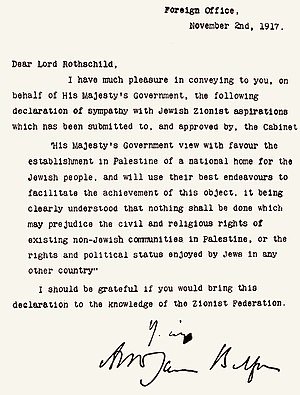Balfour Declaration of 1917
The Balfour Declaration was a letter from British Foreign Secretary Arthur Balfour to banker and prominent Jewish leader (Zionist) Walter Rothschild, 2nd Baron Rothschild, dated 2 November 1917.
The Balfour Declaration of 1917 consisted of a public statement by the government of the United Kingdom during the First World War. In this letter, The declaration, Arthur Balfour declared on behalf of His Majesty's Government, that Britain supported plans for a Jewish homeland in Palestine.
The issuance of the Declaration had many long lasting consequences, and was a key moment in the lead-up to the Arab–Israeli conflict, often referred to as the world's "most intractable conflict".
Balfour Declaration Of 1917 Media
"Memorandum to the Protestant Powers of the North of Europe and America", published in the Colonial Times (Hobart, Tasmania, Australia), in 1841
The "Basel program" approved at the 1897 First Zionist Congress. The first line states: "Zionism seeks to establish a home (Heimstätte) for the Jewish people in Palestine secured under public law"
Herbert Samuel's Cabinet memorandum, The Future of Palestine, as published in the British Cabinet papers (CAB 37/123/43), as at 21 January 1915
Lord Curzon's 26 October 1917 cabinet memorandum, circulated one week prior to the declaration, addressed the meaning of the phrase "a National Home for the Jewish race in Palestine", noting the range of different opinions[1]
Edwin Montagu, the only Jew in a senior British government position,[2] wrote a 23 August 1917 memorandum stating his belief that: "the policy of His Majesty's Government is anti-Semitic in result and will prove a rallying ground for anti-Semites in every country of the world."
Balfour Declaration as published in The Times, 9 November 1917
- ↑ Curzon 1917.
- ↑ Schneer 2010, p. 193.
